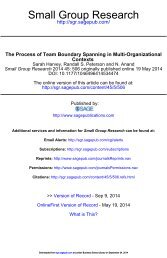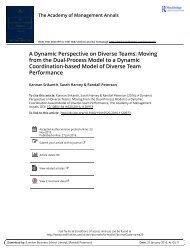Group Dynamics in Top Management Teams: Groupthink, Vigilance, and Alternative Models of Organizational Failure and Success
This study explored the heuristic value of Janis’ (1982) groupthink and vigilant decision making models as explanations of failure and success in top management team decision making using the Organizational Group Dynamics Q-sort (GDQ). Top management teams of seven Fortune 500 companies were examined at two historical junctures—one when the team was successful (defined as satisfying strategic constituencies) and one when the team was unsuccessful. Results strongly supported the notion that a group’s decision making process is systematically related to the outcomes experienced by the team. Ideal-type Q-sorts organized around Janis’ analysis of groupthink and vigilance were substantially correlated with Q-sorts of failing and successful groups, respectively. The fit was, however, far from perfect. Ideal type Q-sorts derived from other frameworks correlated better with the failure–success classification than did the Janis-derived ideal types. Successful groups showed some indicators of groupthink (e.g., risk-taking, cohesion, and strong, opinionated leaders), whereas unsuccessful groups showed signs of vigilance (e.g., internal debate to the point of factionalism). The results illustrate the usefulness of the GDQ for developing and empirically testing theory in organizational behavior from historical cases.
This study explored the heuristic value of Janis’ (1982) groupthink
and vigilant decision making models as explanations of
failure and success in top management team decision making
using the Organizational Group Dynamics Q-sort (GDQ). Top
management teams of seven Fortune 500 companies were examined
at two historical junctures—one when the team was successful
(defined as satisfying strategic constituencies) and one when the team was unsuccessful. Results strongly supported the notion
that a group’s decision making process is systematically related
to the outcomes experienced by the team. Ideal-type Q-sorts organized
around Janis’ analysis of groupthink and vigilance were
substantially correlated with Q-sorts of failing and successful
groups, respectively. The fit was, however, far from perfect. Ideal type
Q-sorts derived from other frameworks correlated better
with the failure–success classification than did the Janis-derived
ideal types. Successful groups showed some indicators of groupthink
(e.g., risk-taking, cohesion, and strong, opinionated leaders),
whereas unsuccessful groups showed signs of vigilance (e.g.,
internal debate to the point of factionalism). The results illustrate
the usefulness of the GDQ for developing and empirically testing
theory in organizational behavior from historical cases.
- No tags were found...
Create successful ePaper yourself
Turn your PDF publications into a flip-book with our unique Google optimized e-Paper software.
TOP MANAGEMENT TEAMS 299<br />
APPENDIX B—Cont<strong>in</strong>ued<br />
Decentralization–Centralization <strong>of</strong> Power<br />
4. ***The group deeply dislikes delegat<strong>in</strong>g power <strong>and</strong> shar<strong>in</strong>g responsibility (i.e., control must<br />
be all or noth<strong>in</strong>g).<br />
vs<br />
The group appreciates the value <strong>in</strong> delegat<strong>in</strong>g power <strong>and</strong> liv<strong>in</strong>g with fluid, power-shar<strong>in</strong>g relationships.<br />
5. ***The group believes <strong>in</strong> a top-down, pyramidal, <strong>and</strong> control-oriented style <strong>of</strong> management<br />
(i.e., lots <strong>of</strong> rules, checks, <strong>and</strong> surveillance).<br />
vs<br />
The group believes <strong>in</strong> a bottom-up style <strong>of</strong> management that encourages <strong>in</strong>itiative <strong>and</strong> selfcontrol<br />
among employees with m<strong>in</strong>imal reliance on formal rules <strong>and</strong> surveillance.<br />
6. The group is aware <strong>of</strong> <strong>and</strong> believes that it should be responsive to community concerns.<br />
vs<br />
***The group is oblivious to or ignores community concerns.<br />
12. ***The group cloaks its deliberations <strong>in</strong> the highest secrecy.<br />
vs<br />
The group is remarkably open about its deliberations with those outside the group.<br />
53. ***Power is concentrated with<strong>in</strong> a small subgroup.<br />
vs<br />
Power is dispersed across a wide range <strong>of</strong> constituencies <strong>and</strong> <strong>in</strong>terest groups.<br />
82. The group believes that it should be responsive to employee concerns.<br />
vs<br />
***The group is oblivious to employee concerns (<strong>in</strong> extreme cases may even be hostile to<br />
employee concerns).<br />
Risk Aversion–Risk Tak<strong>in</strong>g<br />
25. ***Advocates <strong>of</strong> a more risk-tak<strong>in</strong>g bus<strong>in</strong>ess strategy hold the upper h<strong>and</strong> with<strong>in</strong> the<br />
group.<br />
vs<br />
Advocates <strong>of</strong> a more cautious strategy hold the upper h<strong>and</strong> with<strong>in</strong> the group.<br />
29. ***The group consists <strong>of</strong> visionaries driven to achieve extremely ambitious objectives.<br />
vs<br />
The group consists <strong>of</strong> “satisficers” content with adopt<strong>in</strong>g any acceptable option that<br />
comes along.<br />
50. The group attaches great importance to preserv<strong>in</strong>g traditional arrangements <strong>and</strong> underst<strong>and</strong><strong>in</strong>gs.<br />
vs<br />
***The group attaches no importance to preserv<strong>in</strong>g traditional arrangements <strong>and</strong> underst<strong>and</strong><strong>in</strong>gs.<br />
62. ***The group pursues bold or high-risk <strong>in</strong>itiatives.<br />
vs<br />
The group acts <strong>in</strong> highly cautious or risk-averse ways.<br />
84. The leader has positioned himself/herself <strong>in</strong> the middle <strong>of</strong> the cont<strong>in</strong>uum <strong>of</strong> op<strong>in</strong>ion with<strong>in</strong><br />
the group.<br />
vs<br />
***The leader is identified with an extremist w<strong>in</strong>g <strong>of</strong> the group.<br />
87. ***There is a radical atmosphere <strong>in</strong> the group (i.e., reth<strong>in</strong>k old approaches, adopt new<br />
strategies <strong>and</strong> goals).<br />
vs<br />
There is a conservative (don’t-rock-the-boat) atmosphere <strong>in</strong> the group.

















